Blog 1: Chase County: Empty Lie
In Outline Map of Chase Co. Kansas, 1901, proposed by the Northwest Publishing Company, land appears as if it is easily divided and controlled. The map itself gives the audience the idea that the rural western states are under the domain of man. The precise tooling required used to separate the lines down into individual sections give the viewer the idea of an urban environment in a way. The Homestead Act of 1862 gave heads of households 160 acres of land out in the rural states out west. The act itself was meant to help incentivize people to move west and use the millions of acres available.
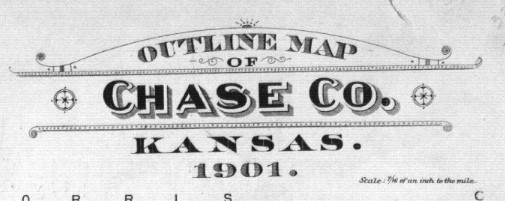
The map appears as a simple yet detailed display of the county lines, infrastructure, and nearly every aspect of the mapped area down to the smallest creek crossing. But the map itself can be seen as a primary source from the era to depict how confidently geographers and cartographers compartmentalized and dedicated land that was available.
Land and borders were no longer determined by creeks, railroads, or even topography. This is seen in PraryErth by William Least Heat-Moon.

Land had become a commodity and a weapon during the time of the creation of the map of Chase County. It was commodified in the way that appeared simple and monotonous enough for Americans to relocate themselves in rural areas like Chase County. The Homestead Act was also utilized as a weapon against the native population in the area.
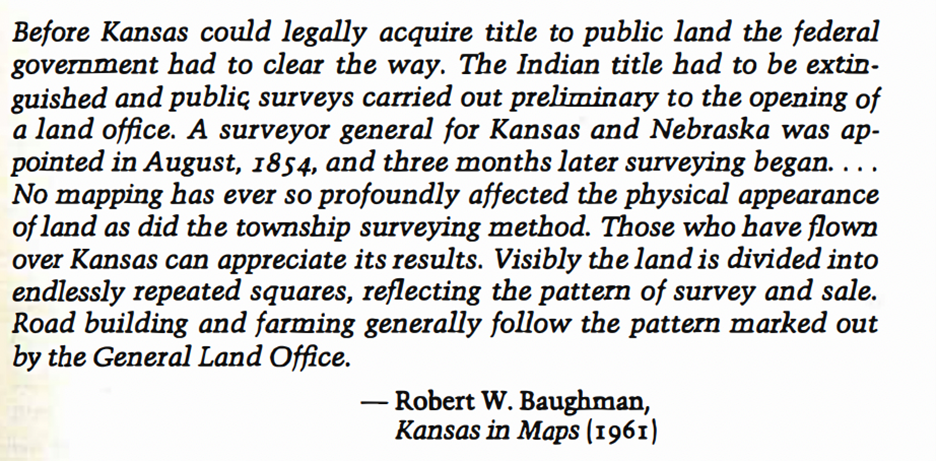
The native population surrounding rural communities like Chase County did not view land ownership, nor land as something to control or take dominion over. As seen in multiple sources, including A Topographic Map of Words Parables Of Cartography In William Least Heat-Moon’s PrairyErth by O. Alan Weltzien. Weltzien’s writings regard parts of Heat-Moon’s book regarding the differences in native ideas of land versus colonial America’s policies. Both pieces of writing can be seen to support the idea that policies like the Homestead act of 1862 was a method to remove natives by encroachment.
The Map of Chase County is a display of America’s ideas of domination over the land. The reasoning behind the “crossings” on the map are used to incentivize settlers, reduce land to a commodity, and weaponize the land to defeat an enemy with different beliefs.
Plat book, Chase County, Kansas – 2
A Topographic Map of Words Parables Of Cartography In William Least Heat-Moon’s PrairyErth: Alan Weltzien
PrairyErth (A deep map): William Least Heat-Moon
Blog Post #1: Chase County Kansas
In 1862, the Homestead Act was passed which allowed a certain amount of land to be owned by settlers to cultivate and farm. This pushed an increasing amount of settlers to move out west and establish their claim in the vast lands of the west and Midwestern United States. One of the counties where immigrants and settlers flocked to was Chase County Kansas.
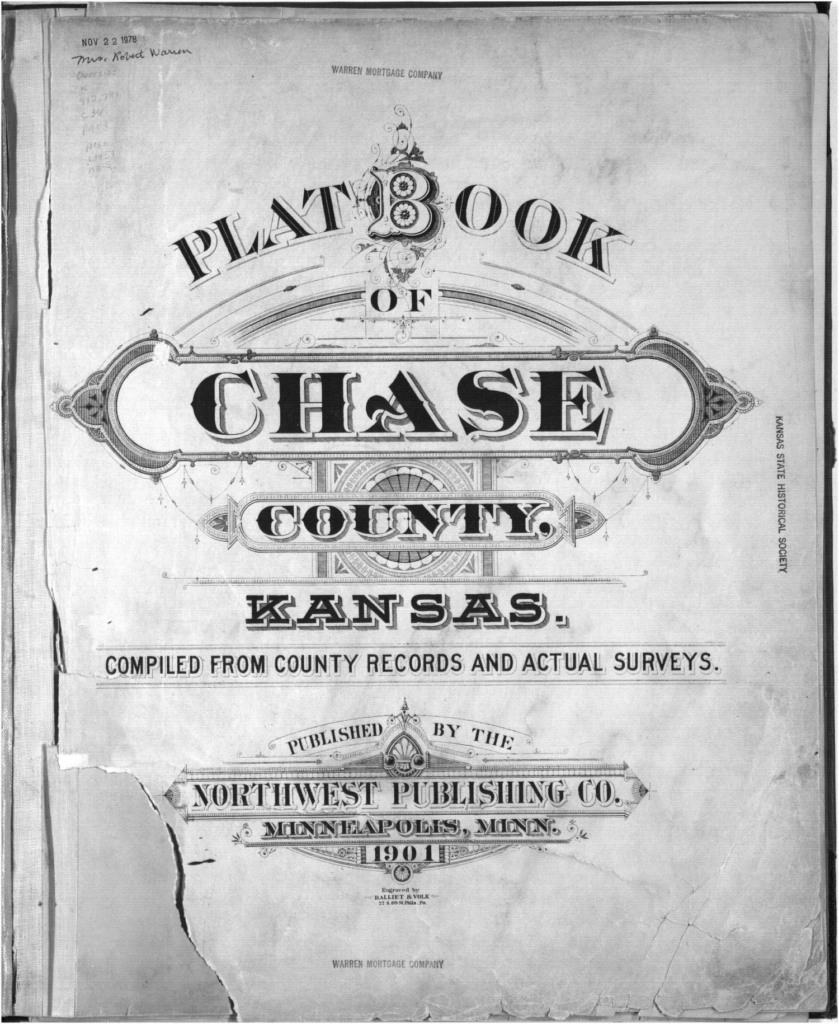
The 1901 map of Chase County Kansas is typical for a map of a “frontier” town. Its a simple design that contains landmarks and other sites that would be important to settlers. Some of these landmarks are churches, school houses, county stores, and the path the railroad would take. Perhaps the most interesting feature on the map is the appearance of valuable farm land on the map and land that is already owned.

The size of the available farm land is what initially drew settlers to the plains of Kansas/”flint hills.” Before the flint hills was found to be too rocky and the soil was found to contain too much flint. The area of Chase County was an attractive place to settle for new immigrants coming into the Kansas territory. This is in large part thanks to the railroad which brought business, settlers, and supplies to the county and community. However, the designation of owned property and property lines would “possibly” give a way for the county to determine the annual census. And to decrease the chance for property disputes to occur.
Which brings me to my conclusion on the “Chase County Map.” I believe that the map was made to serve as a guide to new settlers/visitors. One, the map contains landmarks and where they are located within Chase County. Giving new people a reference of what is located in Chase county and the path that the railroad takes through town. Also, the markings of available farmland in Chase County shows new settlers what land is available for cultivation. And what land can legally be purchased by the new settlers moving into Chase County. The designation of purchased/owned land prevents new settlers from clamming land that is already owned. Thus, preventing property disputes or lawsuits taking place for control of the land.
Emma Reed, Blog Post 1: Chase County, Kansas
The Outline Map of Chase Co. Kansas, 1901 looks as though it is a relatively simple map. However, upon further investigation, it becomes apparent that it intends to increase the movement of people and settlement within the region. Since the author of this map was Warren Mortgage Company, one can imply that the intended purpose of the map was to increase settlement, and therefore increase the economic state of the County.
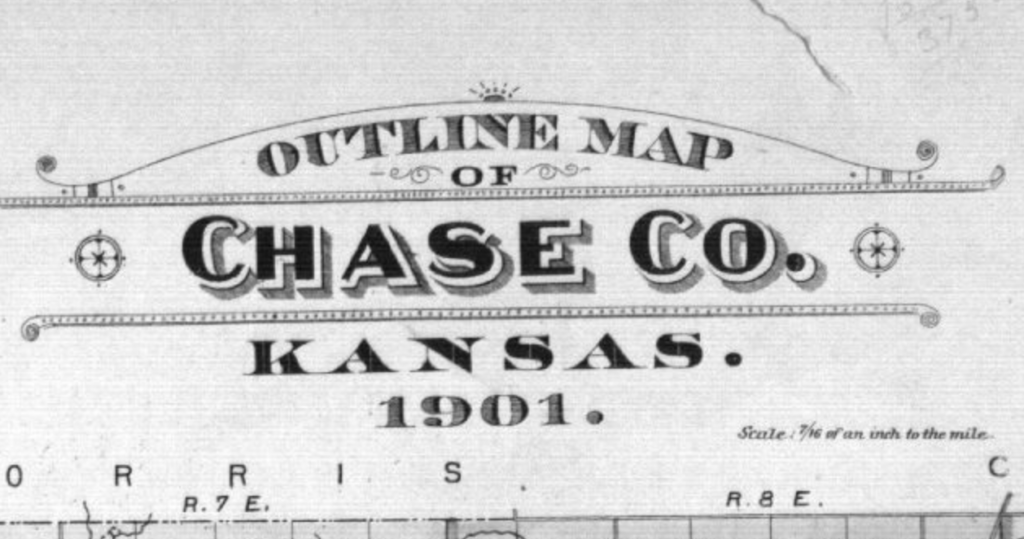
This map depicts important information for prospective settlers such as schools, churches, post offices, and more. Going into more detail, one gets to the heart of the map argument as seen through its depiction of railroads, wagon roads, and lot lines. These lines do not just show means of travel throughout the area, but also showcase the areas of land that settlers could live on.
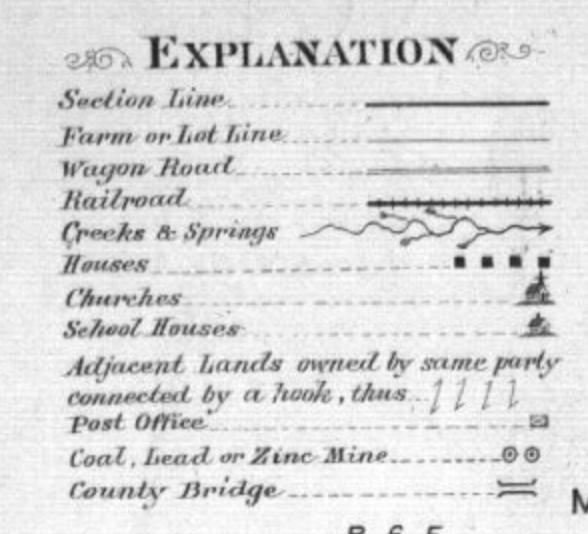
PrairyErth shows Chase County from a different perspective that can help create a more holistic understanding of the region and its settlers. The map looks at Chase County more from the angle of culture and the traditions that the settlers have as it shows quotes from those who live there. Through this, viewers can come to learn about their way of life and particularly how important farming is in their community.
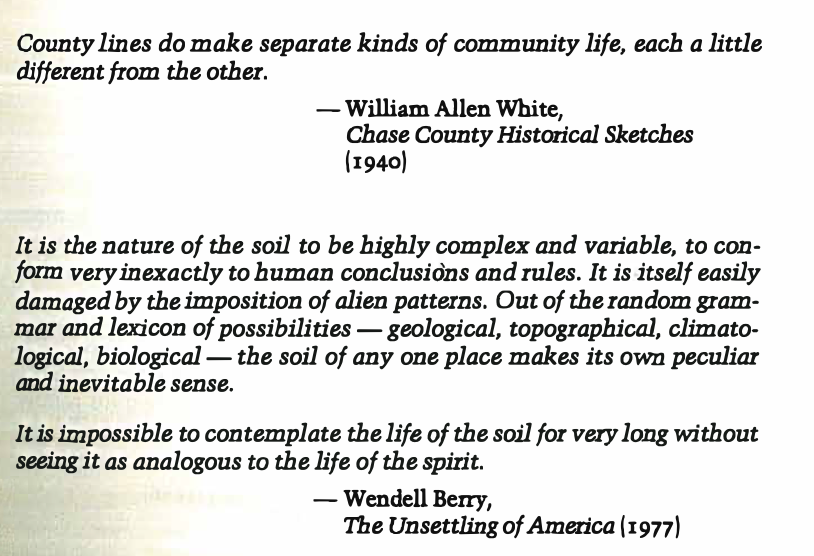
Finally, these maps showcase the different aspects of Chase County but they both have the end goal of increasing settlement. The Outline Map of Chase Co. Kansas, 1901 looks at the region through the lens of economics while the PrairyErth map looks at the region from the approach of culture. Both provide needed backgrounds on the County for incoming settlers but have different approaches as to achieving that.
Chase County, Kansas Blog Post 1 Michael Lau
The Plat Book of Chase County, Kansas, is a property map from 1901. Published by the Warren Mortgage company, the map features no topography or latitude or longitude lines which would indicate a travel map. However, in its legend, it does indicate the various modes and methods of travel that are placed throughout Chase County. The county, however, is split into townships, with each of them being a parceled out more into differing estates. All of them numbered. Towns and cities are hatch marks, with the map taking particular focus on the transportation and the public services in each area. The Legend hinting to their priorities as schools and churches are given a symbol.

The map has several hand drawn additions and math surrounding it. It appears that the map was for investors in the region, or new homesteaders, to mortgage their land from the Warren Mortgage Company.

At the same time, this audience would either be locals or completely blind to the kind of land that they were buying, as besides whether there was a river on the property, there is no topological or ecological data present on the map. The people buying this land were thus not farmers or those who cared about the land other than for its location. O. Allen Weltzen quotes the geographer Yi Fu Tian in saying.
“A geographer studies landscape “from ‘above,'” for example, but The side view … is personal, moral, and aesthetic. A person is in the landscape … from a particular spot and not from an abstract point in space.”
– Yi Fu Tian
In other words, every map is a metaphor and a lie. Thus, what is actually on these lands that the Warren Mortgage company doesn’t want its audience to find out? William Least Heat-Moon, the focus of O. Allen Weltzen essay, finds that;

Chase County, which the Flint Hills is a part of, is not a just some blank slate for real estate and state entities to draw on, it contains a unique ecological treasure that has been recognized today, though maybe less treasured back in 1901. So what does that say about the audience for this map? Were they settlers? Homesteaders? Regular people? It almost certainly wasn’t an indigenous group, as according to Heat-Moon, their relationship with the land was certainly more emotional and spiritual than the cold calculations on the side of a blank map would seem.
Perhaps then, the priorities of those drawing the borders and buying the land were never after the richness of the land itself, but the clinical calculus of economics and progress.
Bibliography
“Kansas Memory.” Kansas Memory – Main Page, Northwest Publishing Co., www.kansasmemory.org/item/209375/page/3. Accessed 28 Jan. 2024.
Weltzien, O. Alan. “A Topographic Map of Words: Parables of Cartography in William Least Heat-Moon’s PrairyErth.” Great Plains Quarterly, vol. 19, no. 2, Spring 1999, pp. 107–122.
William Least Heat-Moon. PrairyErth: (A Deep Map). Houghton Mifflin Company, 1991. Pages 3-24.
Erin Buglewicz, Blog Post 1: Chase County, Kansas
At first glance, the Outline Map of Chase Co. Kansas, 1901 appears to be nothing more than a simple reference map. However, by giving it a closer look and considering historical context, this map creates a proposition about land and settlement in Chase County.
The 1862 Homestead Act allotted 160 acres of federal land to each adult or head of household, and this encouraged people to settle in the American West. This map depicts land still open for settlement and sale in 1901, and this is denoted by the “Warren Mortgage Company” stamp in the top right corner of the map. On the top left, there is a key (titled “Explanations”) that lists symbols for infrastructure, such as railroads, schools, and post offices, which would be important to people looking to settle there. The purpose of this is to show, as William Least Heat-Moon explains, that Kansas serves as an intersection within the United States, and it is not merely “barren, desolate, monotonous” (10).

However, it is important to note an obvious silence in this map: the presence of Native American land. In Heat-Moon’s book, PrairyErth, he quotes Robert W. Baughman to note that before land could be sold, the government first needed to “clear the way” by removing indigenous peoples from their lands.

As Heat-Moon depicts, many incoming settlers held the false notion that the land in the West was nearly empty. He effectively explains this idea by contrasting an overhead view, such as one seen from above in an airplane, that consists of twelve quadrants to a more detailed “deep map” of Chase County.

In doing so, Heat-Moon is trying to combat the myth of emptiness within Midwestern states like Kansas. Due to his heritage and background, he also acknowledges the tie that Native Americans have to the land by including a short story.

Different groups will interpret Heat-Moon’s depiction of Chase County in twelve quadrants in their own ways. In one aspect, it compares to the Outline Map of Chase Co. Kansas, 1901 because it depicts large white spaces, seemingly showing open plots of land. However, for Native Americans, these white grids showed that vastness of their land and their belief that the open land should not be subdued or sold.
References:
Heat-Moon, William Least. PrairyErth. London: Andre Deutsch. 1991.
“Outline Map of Chase Co., Kansas, 1901.,” Northwest Publishing. https://www.kansasmemory.org/item/209375/page/3.
Blog Post 1: Chase County Kansas
In two different maps of Chase County, Kansas, we can see that Kansas is more than just the landscape that is broken up into sections.
The first of the maps is the Outline Map of Chase Co. Kansas, 1901. This map was published by Northwest Publishing in Minneapolis, Minnesota.

This map is a reference map of the county laid out in a grid and provides a brief overview of various landscapes found within the county including rivers, churches, plot lines, wagon roads, railroads, schoolhouses, mines, and many more as outlined in the key in the upper right of the map.

The second of the maps is a Deep Map called PrairyErth, 1991, created by William Least Heat-Moon, a travel writer and historian.

PrairyErth is considered to be a Deep Map since it gathers and conveys its information by using other disciplines other than maps including, history and archaeology. Overall, the deep map is far less visual than the other map as it uses some maps but more so written metaphors and stories. PrairyErth breaks down Chase County, Kansas into regions and discusses them individually.
Looking at one map portrayed in PrairyErth, we can see a similar map style compared to the previous map. The map is also a reference map but includes similar a different things than the previous map. Both maps show the various towns, rivers, and railroads. The PrairyErth map shows a more modern-day look at Chase County. This can be inferred based on the inclusion of various highways and interstates such as the Kansas Turnpike also known as I-35.

Despite being nearly 90 years apart, the maps have similar arguments. I believe they both show what is deemed as important at the time of the map’s respective creations and omit what is deemed not as important. In both maps, there is an emphasis on transportation even though it has evolved from wagon roads to interstates. The more modern map omits items shown in the previous map such as the school houses and church. This could be because there are too many of them within the towns or the map maker does not deem them as important. These two maps together show the evolution of Chase County, Kansas, and allow the audience to see what was important at the time of the map’s creation and how interests have changed over time.
References:
Heat-Moon, William Least. PrairyErth. London: Andre Deutsch. 1991.
“Outline Map of Chase Co., Kansas, 1901.,” Northwest Publishing. https://www.kansasmemory.org/item/209375/ Accessed on 1/22/2024
Leah R.K. – Post No.1 – Chase County Outline Map
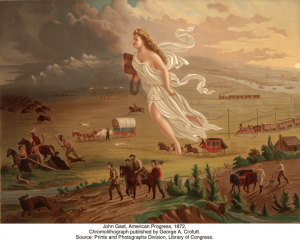
Picturing U.S. History
The Chase County Outline Map was a proposal made by the Northwest Publishing Company in 1901 to any prospective buyer telling them that a bountiful amount of land was waiting for them to stake their ‘rightful’ claim on. This argument was heavily inspired by the present cultural ideal of ‘American Progress’ and the bringing of order to wild and unpredictable lands.

Historic Map Works
This cultural understanding of the world surrounding them which influenced them to make this argument at the time is featured heavily in this map above through the superimposed lines that divided up vast, unknown, landscapes into small, manageable plots of land many would soon come to lay their claim on.

Historic Map Works
Not only does this map make simple something as complicated as nature, but it was also made to argue that this land was unquestionably the buyer’s own and that these prospective settlers had every right to come and live off of land they had never even seen at that point before. These efforts are made visible through silences such as the little effort made to disclose what groups occupied this land before the settlers. The only land markers being one’s previous settlers before them took efforts to construct such as houses, churches, wagons & railroads, &c. The red, yellow, and blue/green overlay indicates the names of subsections of Chase County such as Diamond Creek, Cottonwood Falls, and Toledo.
The Northwest Publishing Company made this map with economic intent too though. There was more to be gained than just the subjugation of a foreign environment in it for them. Every number had a price tag and that money would be going to them, progress always comes with a cost, and this factor also distinctly determines what was and wasn’t included in the publication of this map. As with most territorial maps from this era, the landscape of Chase County is oversimplified with no indication of level elevation, soil quality, or the names of the indigenous groups that could also be occupying the land. This is done so as not to give the prospective buyer any reason to think twice about buying and cultivating the land. Once it’s been purchased there is no way for that individual/family to get their money back, so any unfavorable conditions are ignored/swept off to the side.
Chase County Outline Map, Atlas: Chase County 1901, Kansas Historical Map (historicmapworks.com)
Picturing US History – John Gast, American Progress, 1872 (cuny.edu)
Madeline King, Blog Post 1: Chase County, Kansas – A Home
In two different maps, the sparsely populated Chase County, Kansas is shown to contain far more than just the divided landscape typically seen out a plane window in “flyover country.”
The first of the maps is the Outline Map of Chase Co. Kansas, 1901. This map was published by Northwest Publishing in Minneapolis, Minnesota.

Outline Map of Chase Co, KS. 1901.
This map takes a reference map. Laid out in a grid, the map illustrates a brief overview of Chase County and the various things found there, like rivers, plots of land (for farms), churches, post offices, and it identifies different settlements throughout the County (all illustrated with symbols identified in an explanatory key (circled). In order to encompass the range of land taken up by Chase County, the symbols appear on a small scale on the map.
The second of the maps is a Deep Map called PrairyErth, 1991, composed by William Least Heat-Moon, a travel writer and historian.
William Least Heat-Moon, PrairyErth, 1991
PrairyErth is described as a Deep Map, as it gathers and conveys its information in a much through cartography, history, archaeology, and other disciplines. It is far less visual than the previous map. It is mostly conveyed in written metaphors and stories. While the previous map encompassed all of Chase County at once, PrairyErth breaks down Chase County into regions and discusses them chapter by chapter.
Despite being so visually different, these two maps make one similar argument. Both maps make an argument that Chase County is a home. The explanatory key provided in the first map identifies places in Chase County like farms, wagon roads, houses, churches, and schools. These things are all more than just part of the landscape. They identify Chase County as a place that is lived and worked in. This sentiment is shared by Heat-Moon within his deep map. Heat Moon’s map contains quotes like “County lines do make separate kinds of community life, each a little different from the other,” identifying how a rural life develops community (Heat Moon, 7). The second map discusses how this population lives their lives with a singular high school, only a small amount of attorneys, and a need to travel to find other professions like doctors.
While Chase County is small in its population per area, both of these maps demonstrate that this “fly over country” and seemingly barren and empty prairie contains a home and way of life for people.
References:
Heat-Moon, William Least. PrairyErth. London: Andre Deutsch. 1991.
“Outline Map of Chase Co., Kansas, 1901.,” Northwest Publishing. https://www.kansasmemory.org/item/209375/ Accessed on 1/22/2024
Blog Post 1: Chase County, KS
This 1901 map of Chase County, KS looks to be meant to advertise and/ or sell land plots in Chase County. This reference map divides Chase County into grids in order to easily identify where natural landmarks like rivers and creeks lay in relation to buildings like houses, schoolhouses, and churches.
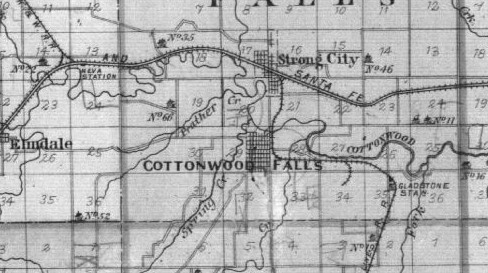
Dually, this map aims to show the openness of Chase County in an attempt to lure settlers to buy land. Many grids are completely empty and do not display any descriptions of the land’s topography or layout. The emptiness of a grid would display to the audience that the land was barren and easy to build upon and live off of.
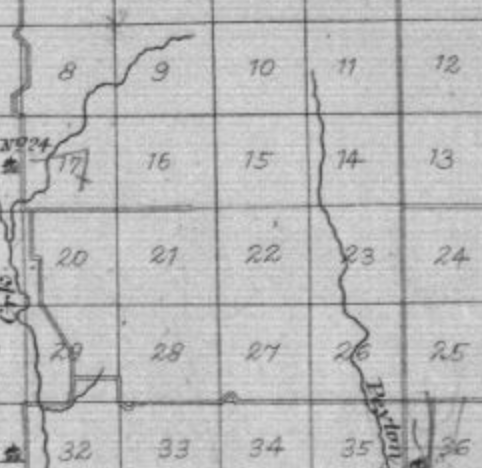
Opens grids like 21 and 28 depicted above would lead the audience to assume the land was just a flat plot without any obstacles or landmarks in or around it.
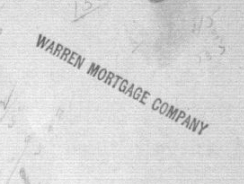
At the top of the map the words “Warren Mortgage Company” lead me to find that this map was an advertisement and used as a tool to help sell these plots of land. It also helps explain why the detail of the map is very simple. This map is not intended to be a navigational map to lead the audience but to show the audience the availability of land plots in the county in the early 1900’s.
The Chase County area was also written about in a way to fill in these blank spaces in William Least-Heat Moon’s PrairyErth (A Deep Map).
Least- Heat Moon’s PrairyErth holds quotes about and accounts from the Chase County area that detail the land and how it is more than just empty plots on a map. While maps like the 1901 account by the Warren Mortgage Company can be helpful for audiences looking to buy land and settle in the Chase County area, it is important to note that it does not display the fullness and detail of each inch of land.



